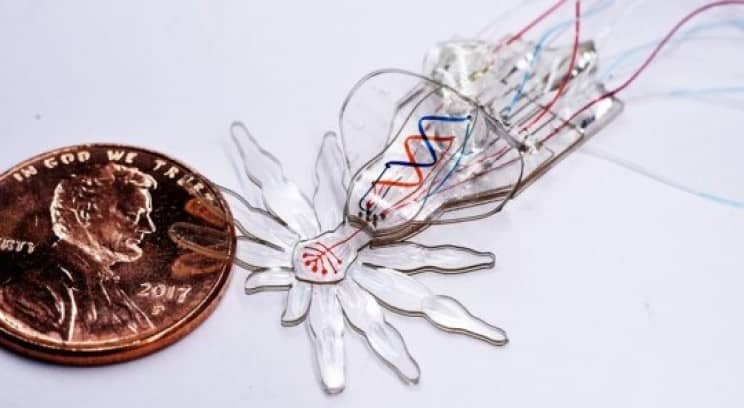A team of researchers is developing small spider-like robots which are inspired by common Arachnids. They measure only a few centimeters in size and have the tools which are needed to work at the points where rigid robots cannot reach. Roboticists and researchers from Harvard University’s Wyss Institute for Biologically Inspired Engineering, Harvard John A. Paulson School of Engineering and Applied Sciences (SEAS), and Boston University are the people behind the creation of these tiny robotic creatures. The soft robotic spider shows how a robot on the millimeter scale with a micrometer-sized feature can pack powerful and impressive performance.
The inspiration to build this robot came from the millimeter-sized Australian peacock spider. The robot uses a single elastic material which is capable of body-morphing, motion, and has color. Sheila Russo, a co-author of the study, said, “The smallest soft robotic systems still tend to be very simple, with usually only one degree of freedom, which means that they can only actuate one particular change in shape or type of movement. By developing a new hybrid technology that merges three different fabrication techniques, we created a soft robotic spider made only of silicone rubber with 18 degrees of freedom, encompassing changes in structure, motion, and color, and with tiny features in the micrometer range.”
Robert Wood, who serves as a Core Faculty member and co-leader of the Bioinspired Soft Robotics program at Wyss Institute, said, “In the realm of soft robotic devices, this new fabrication approach can pave the way toward achieving similar levels of complexity and functionality on this small scale as those exhibited by their rigid counterparts,” said Wood. “In the future, it can also help us emulate and understand structure-function relationships in small animals much better than rigid robots can.” The tiny robot-spider also called Microfluidic Origami for Reconfigurable Pneumatic/Hydraulic devices or MORPH. The team used a lithography technique to create 12 layers of elastic silicon to make the soft spider’s body.
Each layer of the body is precisely cut using a micro-machining technique. The layers are then bonded together to create a 3D structure of the spider. Making the spider move was another task and the team needed to weave the micro-fluidic channels into the elastic silicon layers. The researchers used injection-induced self-folding and pressurized channels. Tommaso Ranzani, Ph.D., Assistant Professor at Boston University said, “We can precisely control this origami-like folding process by varying the thickness and relative consistency of the silicone material adjacent to the channels across different layers or by laser-cutting at different distances from the channels. During pressurization, the channels then function as actuators that induce a permanent structural change.”
The remaining channels were then used to give color to the eyes and simulate the color patterns which are found on the real spiders. Razani said, “This first MORPH system was fabricated in a single, monolithic process that can be performed in few days and easily iterated in design optimization efforts.” The researchers hope that this tiny spider will prove to be effective in various situations. Donald Ingber, Wyss Institute Director, said, “The MORPH approach could open up the field of soft robotics to researchers who are more focused on medical applications where the smaller sizes and flexibility of these robots could enable an entirely new approach to endoscopy and microsurgery.”

